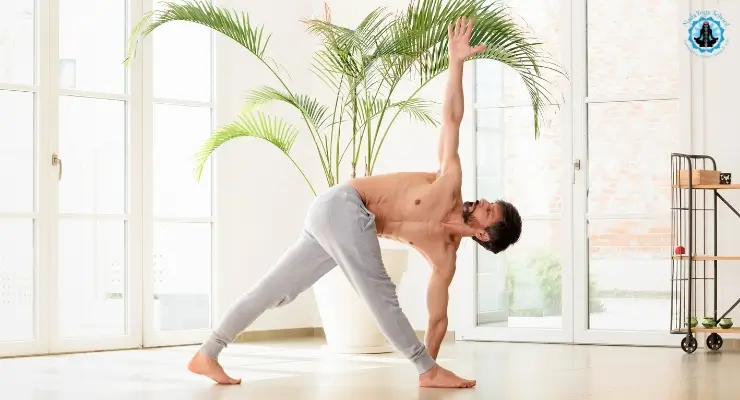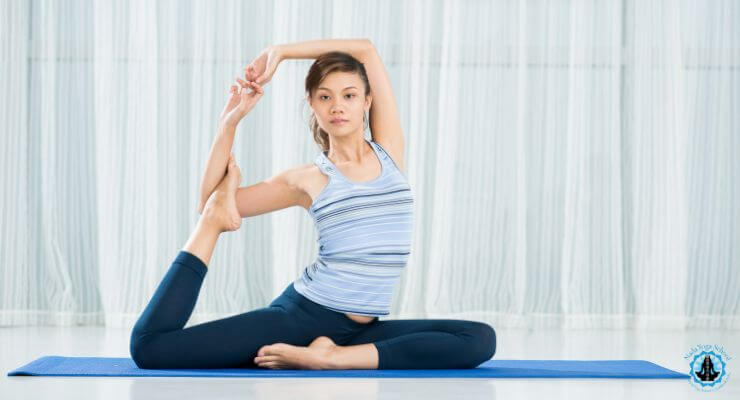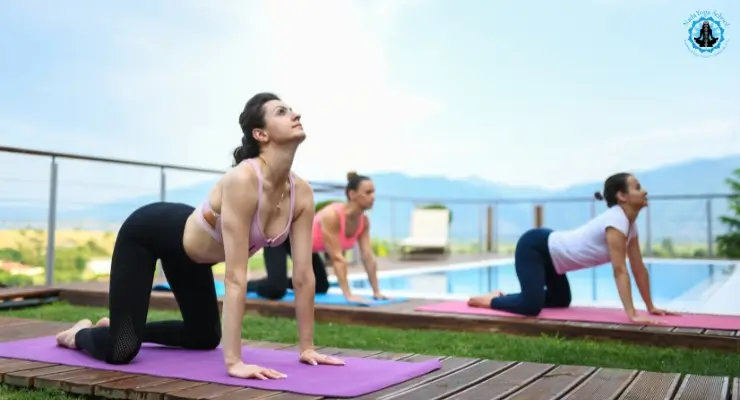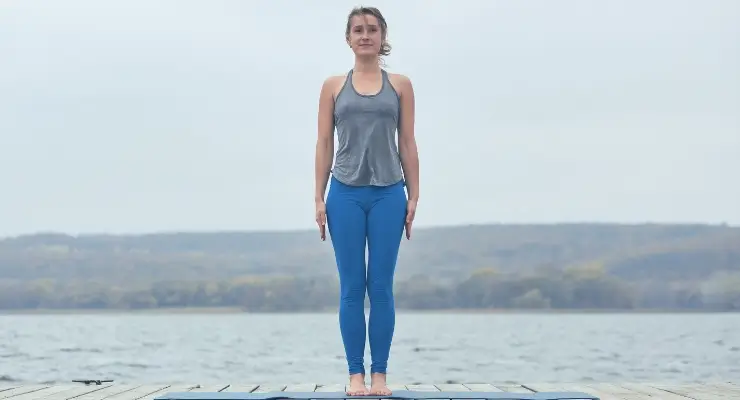Parivrtta Trikonasana or the revolved triangle pose is yoga asana while standing.
It is pronounced as (par-ee-vrit-tah trik-cone-AHS-anna).
The name of this yoga asana comes from the Sanskrit language and is a combination of three words. The word Parivrtta means “to revolve”, the word Trikona means “triangle” and the word asana means “yoga posture”.
This yoga asana requires flexibility and balance. While performing this asana, the feet are placed just the way they are placed in the warrior pose or the Virabhadrasana 1.
Parivrtta Trikonasana is basically nothing but an advanced variation of triangle pose or trikonasana.
This asana is used to stimulate the svadisthana chakra or the sacral chakra. With the activation of this chakra, the practitioner becomes open to pleasure, creativity, joy and self-worth.
It is also known to stimulate passion, stoke the digestive fire and awaken the Kundalini energy.
Anybody who lacks the balance or the flexibility to perform this asana can use a block in order to support the arm which is reaching towards the ground.
Step by step instructions to perform Parivrtta Trikonasana:
- Start this asana by getting in the mountain pose or the Tadasana.
- Now, with your right foot take an almost three-foot step in the backward direction and turn it around 25 degrees to your side. Make sure that your left toe is pointing in the forward direction. At this stage, your buttock should face the side of the yoga mat. Quickly check the way your feet are aligned. They should be kept almost hip-width apart from each other with the heels being aligned with each other. The arch and heel of the foot must be aligned as well.
- Now place your left hand on your waist while raising your right hand in the upward direction to elongate your spine.
- Firmly place your back foot on the yoga mat and pull the lower part of your belly to support your lower back. Exhale deeply and hinge in the forward direction at your waist. Ensure that your spine is stretched while you reach out with your right arm.
- Based on your flexibility and range of motion, place your right hand in a way so that it reaches your shin or on the floor in the outside direction of your foot. Inhale deeply and keep extending through the crown of your head while ensuring that your spine is strengthened.
- Now quickly check if your right foot is placed firmly on the ground. Exhale deeply and rotate in the left direction while stretching your left arm in the direction of the sky while gazing at it.
- Breathe deeply and relax while staying in the pose for a few more seconds.
- To come out of this pose, gaze at your left foot while pulling your belly inwards. Then, inhale deeply and rise very slowly. Place both of your hands on the waist while bringing your feet closer. Repeat the same asana with the opposite side.
Benefits of Parivrtta Trikonasana:
Amongst the many benefits of this yoga asana, some of the best benefits are:
- Practicing this yoga asana helps in giving a good stretch to the legs and makes them extremely strong.
- The spine and buttocks also get a good stretch with this yoga asana.
- Practicing this asana regularly opens up the chest area, and so the breathing gets improved to a great extent.
- People who suffer from back pain can benefit from this asana. It helps in relieving from back pain.
- The abdominal organs get stimulated and the digestion also gets improved.
- Concentration, balance, and focus are also improved with regular practice of this asana.
Beginner’s Tip:
This asana requires great flexibility and a sense of balance. If you are just beginning your yoga practice then you make this asana easier by taking a narrow stance. Start by bringing the hand closer in the direction of the inner foot.
Precautions:
While performing the Parivrtta Trikonasana, there are a few things that you should keep in mind:
- If you have a spine or back injury then you are advised to do this yoga asana under the expert supervision of an experienced yoga teacher.
- Students with problems like migraine, low blood pressure, headache, diarrhoea should also avoid doing this yoga asana.
If you’re looking for a truly transformative and authentic experience in your yoga teacher training, I highly recommend Nada Yoga School in Rishikesh, India. Located in the foothills of the Himalayas, Rishikesh is revered as the yoga capital of the world, and attracts thousands of spiritual seekers each year. Nada Yoga School offers a comprehensive 200-hour and 300-hour Yoga teacher training programs that combine traditional yogic philosophy, modern teaching methods, and personalized attention from experienced teachers. The curriculum includes asana practice, pranayama, meditation, anatomy, teaching methodology, and yogic philosophy. Additionally, Nada Yoga School offers opportunities for self-reflection, personal growth, and community service. The peaceful setting, warm hospitality, and the chance to immerse oneself in the authentic Indian culture make Nada Yoga School an excellent choice for those seeking an unforgettable yoga teacher training experience. Join Nada Yoga School in Rishikesh, India and embark on a transformative journey that will leave a lasting impact on your life and teaching. Click here to learn more about upcoming courses and workshops.





